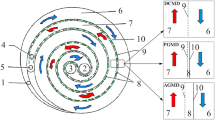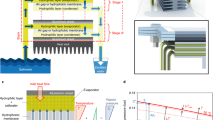Abstract
In this work, several configurations of seawater desalination plant by vacuum membrane distillation were presented. Two types of membranes were studied: flat membranes and hollow fiber modules. These systems use solar energy to supply the heating needs for the seawater to be desalinated. The different possibilities depend on the type of collector used (plan collector (CP), cylindro-parabolic solar collector (CPC), or solar pond (SGSP)) and the nature of the coupling of the module with the collector (integrated or separate module). The type of flow within the fibers (external–internal or internal–external) is a key parameter for the design of these configurations. The performance analysis of the different possible configurations made it possible to compare their productivity according to the type of collector used and to study quantitatively the interest of integrating a hollow fiber module within the solar collector. The study of different configurations made it possible to present the advantages and disadvantages of each configuration. This work made it possible to evaluate the annual production of desalted water by the vacuum membrane distillation; this production varies from 5 to 32.5 m3/m2.
Access provided by Autonomous University of Puebla. Download chapter PDF
Similar content being viewed by others
Keywords
1 Introduction
Conventional desalination processes require large amounts of energy in the form of thermal energy (MED and MSF) or electrical energy (RO). Most desalination plants using these technologies work with fossil fuels, hence the sensitivity to price and availability of oil. To deal with these problems, desalination technologies based on renewable energies are highly desirable. Solar energy is one of the most promising renewable energies in the field of water desalination (El-Nashar 2000).
Membrane distillation (MD) is a thermal membrane separation process which uses hydrophobic porous membranes. The process driving force presents the difference between vapor pressures vis-a-vis the two sides of the membrane (Chamani et al. 2019). The principle of separation by MD is based on the liquid/vapor equilibrium which controls the selectivity of the process (Wang et al. 2017; Cuia et al. 2018; Koa et al. 2018). Despite the exceptional advantages of coupling membrane distillation with solar energy, very few systems have been developed (Gálvez et al. 2009).
In this work, study of the potential of coupling solar energy with vacuum membrane distillation (VMD) and the examination of several possible configurations are presented.
2 Investigated Configurations
2.1 Coupling Possibilities
This study focuses on the two most used module types in VMD which are the plane membrane module and the hollow fiber module. In the case of hollow fibers, two types of arrangements can be defined according to whether the feed circulates inside (external/internal) or outside (internal/external) the fibers.
Regarding solar collectors, the study focuses on three types of collectors: solar pond (SGSP), cylindro-parabolic collector (CPC), and plan collector (PC).
The coupling of membrane module with solar energy has two possibilities:
-
Membranes separated from the solar collector: The water already heated by the solar collector feeds the membrane module whose wall will be insulated to limit thermal losses.
-
Membranes integrated in the solar collector: The membrane module directly receives the solar flux and returns it to the water circulating within the module. In the case of a solar pond (SGSP), the membrane module can be directly immersed in the solar pond. The membrane module has the function of a heat exchanger.
Figure 1 summarizes the multiple studied coupling possibilities. Each intersection point represents a studied configuration of a solar desalination system.
It should be noted that the integration of a plane membrane module into an absorber of a CPC was not considered given the technological difficulty of integrating a parallelepiped module into a cylindrical geometry. Similarly, the case of the hollow fiber module integration in the plan collector has been ruled out due to the incompatibility of geometry.
3 Potential of Different Configurations Results
Models describing the operation of solar collectors, hollow fibers, and plane membrane modules have been developed and presented exhaustively in the following works (Frikha et al. 2017, 2013; Ben Abdallah et al. 2013a, 2013b, 2013c). These different models made it possible to simulate the operation of the different proposed configurations, to study the influence of integration, and to estimate the productivities of each configuration.
3.1 Case of Hollow Fibers
The annual production values of the different studied configurations are summarized in the following Table 1.
Coupling membrane module with a SGSP gives productivities ranging from 11.4 m3/m2 to 18.2 m3/m2 depending on whether the module is integrated or separated. This production is lower than the one observed with CPC because of the high salinity which leads to the reduction of water activity despite the fact that temperature levels are higher. This high salinity causes the decrease of the permeate flux density. The period of operation of the solar pond can last all day, which is not the case for other collectors where productivity is closely related to solar flux.
The plan collector corresponds to the lowest permeate flux densities; this is due to the low temperature levels compared to the other configurations.
The internal–external configuration presents a better production for all of the studied collectors. The productivity improvement is mainly due to the increase of flow velocity within the fibers.
The examination of the various configurations showed the interest of integrating the membrane module into the solar collector. In this case, the integrity of the membrane module is raised to a high temperature; hence, a heat transfer will be more efficient. This possibility makes it possible to reduce heat losses and to have such a compact installation; this leads to an improvement in productivity. However, integration faces several technological constraints. Indeed, since seawater must necessarily pass through the solar collector, it is necessary to use noble materials for the construction of the collector and to overcome corrosion problems.
In addition to the technological constraints, the integration faces a second problem related to the geometrical dependence of the membrane and the absorber. The large gap between the membrane surfaces compared to the collector surface aggravates this limitation. Therefore, with integration, the system will operate below these nominal capacities.
Integration may find its application with collectors having higher concentration factors such as parabolic trough collector (PTC). In such case, the effect of the difference between the capturing surfaces and the membrane surfaces will be reduced.
3.2 Flat Membranes
The same methodology applied in the case of hollow fiber modules has been adopted with flat membrane module.
The comparison of the annual productivities obtained by the three collectors in the case where they are separated from the plane membrane module shows that the best configuration is that of the CPC, followed by the SGSP, and finally the plan collector (Table 2). This is well justified taking into account the temperature levels obtained at the output of the three types of collectors. The productivities per unit area of membranes are close to those obtained with hollow fibers.
Simulation of the distillate production for the configuration of an integrated module shows very low distillate flow rates (less than 14 kg/day/m2). This is due to the insufficient collecting area compared to that of the membrane.
Taking into account the collecting area, the productivity (per unit area of membrane and per unit area of solar collection) offered by the flat membranes is lower than the one relative to the hollow fibers.
The separation of solar collectors from the membrane modules seems like the best solution. The choice of capture surface is made independently of the membrane surface, and therefore, there will not be any energy limitation.
4 Conclusions
In this work, several configurations coupling the VMD process with different solar technologies have been proposed. These configurations are distinguished, in addition to the types of modules and solar collectors used, by the arrangement of the module with respect to the collector (integrated or separate). A comparison of the different configurations made it possible to underline the contribution of the integration of the module in the collector. Indeed, this integration made it possible to improve productivity in all of the studied cases. However, the integration is faced with several technical problems, such as the dependence between the membrane surfaces and the capture surfaces, in addition to the corrosion problems that can be encountered. This study also showed that the internal–external arrangement of fibers is better than the external–internal arrangement. Desalination using solar energy coupled with membrane techniques is a very interesting alternative for the production of drinking water, especially for rural and arid areas.
References
Ben Abdallah, S., Frikha, N., Gabsi, S.: Design of an autonomous solar desalination plant using vacuum membrane distillation, the MEDINA project. Chem. Eng. Res. Des. 91, 2782–2788 (2013a)
Ben Abdallah, S., Frikha, N., Gabsi, S.: Study of the performances of different configurations of seawater desalination with a solar membrane distillation. Desalin. Water Treat 52, 1–10 (2013b)
Ben Abdallah, S., Frikha, N., Gabsi, S.: Simulation of solar vacuum membrane distillation unit. Desalination 324, 87–92 (2013c)
Chamani, H., Matsuura, T., Rana, D., Lan, C.Q.: Modeling of pore wetting in vacuum membrane distillation. J. Membr. Sci. 572, 332–342 (2019)
Cuia, Z., Zhanga, Y., Lia, X., Wanga, X., Driolic, E., Wanga, Z., Zhaod, S.: Optimization of novel composite membranes for water and mineral recovery by vacuum membrane distillation. Desalination 440, 39–47 (2018)
El-Nashar, A.M.: Economics of small solar-assisted multiple-effect stack distillation plants. Desalination 130, 201–215 (2000)
Frikha, N., Ben Abdallah, S., Gabsi, S.: Theoretical study of various configurations of solar desalination by vacuum membrane distillation. Desalin. Water Treat 83, 184–192 (2017)
Frikha, N., Matlaya, R., Chaouachi, B., Gabsi, S.: Simulation of an autonomous solar vacuum membrane distillation for seawater desalination. Desalin. Water Treat. 1–10 (2013)
Gálvez, J.B., García-Rodríguez, L., Martín-Mateos, I.: Seawater desalination by an innovative solar-powered membrane distillation system: the MEDESOL project. Desalination 246, 567–576 (2009)
Koa, C.-C., Alib, A., Driolib, E., Tunga, K.-L., Chena, C.-H., Chena, Y.-R., Macedoniob, F.: Performance of ceramic membrane in vacuum membrane distillation and in vacuum membrane crystallization. Desalination 440, 48–58 (2018)
Wang, H.-Y., Tung, K.-L., Ward, J.D.: Design and economic analysis of membrane-assisted crystallization processes. J. Taiwan Inst. Chem. Eng. 81, 159–169 (2017)
Author information
Authors and Affiliations
Corresponding author
Editor information
Editors and Affiliations
Rights and permissions
Copyright information
© 2022 The Author(s), under exclusive license to Springer Nature Switzerland AG
About this chapter
Cite this chapter
Frikha, N., Abdallah, S.B., Gabsi, S. (2022). Evaluation of the Performance of Membrane Distillation Systems Coupled with Solar Energy. In: Naddeo, V., Choo, KH., Ksibi, M. (eds) Water-Energy-Nexus in the Ecological Transition. Advances in Science, Technology & Innovation. Springer, Cham. https://doi.org/10.1007/978-3-031-00808-5_93
Download citation
DOI: https://doi.org/10.1007/978-3-031-00808-5_93
Published:
Publisher Name: Springer, Cham
Print ISBN: 978-3-031-00807-8
Online ISBN: 978-3-031-00808-5
eBook Packages: Earth and Environmental ScienceEarth and Environmental Science (R0)





